Googleplex: The College-Campus for Professionals
The breakdown of the lifestyle and benefits of Google’s headquarters
Everyone who uses the internet, and even those who don’t, knows the brand name Google. Whether you know them from Gmail, Google Drive, Chrome, or Android, you and everyone you meet in Silicon Valley likely uses one of their products (if not all of the above). This multi-billion dollar company has made a mark just about everywhere, for they have 154 office locations spread throughout the world. In North America alone, Google has set up shop in well known cities from New York to Mountain View. On top of that, Google has a whopping 21 data centers worldwide to keep their products up and running 24 hours a day, 7 days a week.
With such an impressive reach, it comes as no shock that Google has an equally impressive headquarters. We'll break down everything you need to know about this sprawling campus.
Location & Building Design
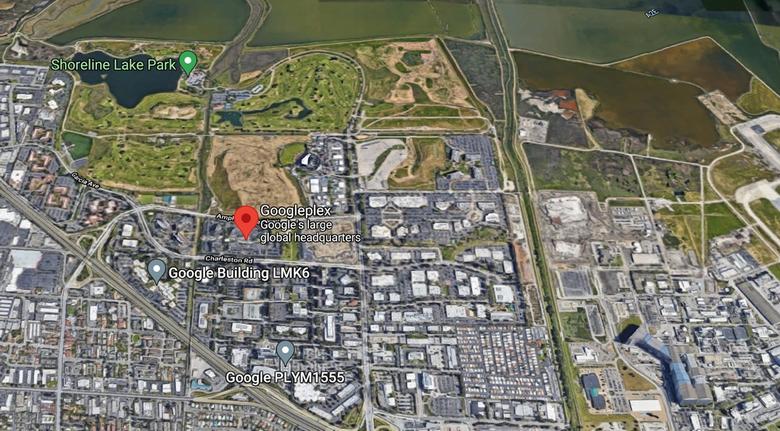
Photo Credit: Google Maps
Google's global headquarters, Googleplex, is established at 1600 Amphitheatre Pkwy, Mountain View, CA. The enormous complex spans around 42 acres and holds 20+ buildings, adding up to around 2 million square feet. While it contains a variety of facilities to work from, its heart rests between buildings 40 through 43. Back in 2013 construction began for one of the newest additions to the campus, nicknamed “Bay View." This expansion will overlook the stunning San Francisco Bay to meet all of Google's aesthetic needs.
The layout of this headquarters was designed with a central square vibe in mind. An important component to this design are the main corridors to navigate the building. Inside, it is lined with “shared-use building blocks” complemented by glass-walled workrooms along the perimeter. This setup is what gives the campus a community feel, where people with their latte and laptop in hand, weave through the walkways and operate both in shared and private spaces.
What makes this campus so interesting is its background. Before Google was in the picture, this headquarters was originally Silicon Graphics’ (SGI) campus. Instead of demolishing it to make way for Googleplex once the lease was in their hands, the designers decided to repurpose the existing structures. The premise they utilized from SGI consisted of all low-rise, modern-style buildings. Several of these are larger, consisting of four levels at a height of about 50 ft, with the rest of the buildings at two levels around a height of 25 ft. This hermit crab mentality is not only eco-friendly, but highlights the creativity that was put into the redesign, spearheaded by Clive Wilkinson Architects.
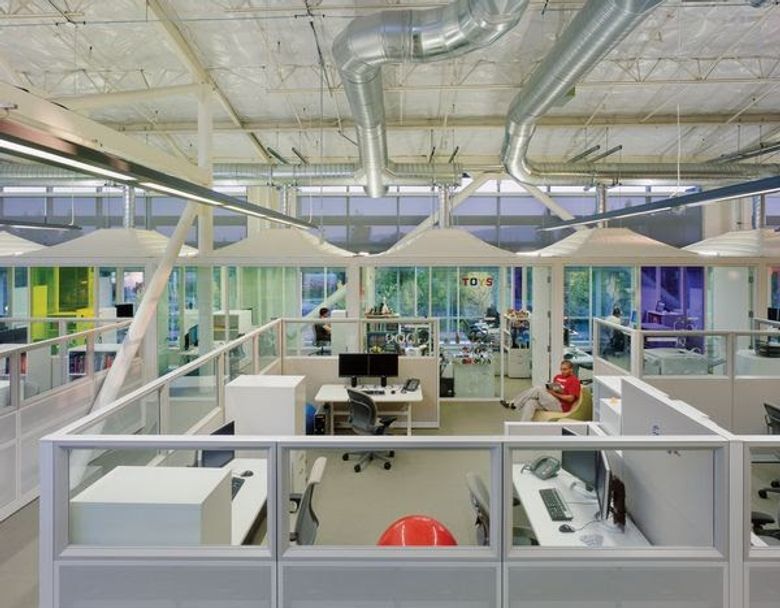
Photo Credit: Pinterest
After careful debate between Wilkinson and Google co-founders Larry Page and Sergey Brin, the architects designed a list of 13 different zones. They arranged these zones from “hot” to “cold” depending on how much interaction is encouraged in a specific space. Every building floor level is distinct, divided into five to six flexible neighborhoods, each of which are separated by notable landmarks. The landmarks are the center of life at Google. These shared public spaces consist of kitchens stocked with snacks, libraries full of games and books, and lounges with comfortable seating and pool tables.
On both sides of the floor, there are elevated structures used as offices and meeting rooms. In the center, there is yet another set of meeting rooms, which are larger and more formal. Other innovative spaces include glass tents and yurts. Glass tents are essential for engineers who need a quiet space to concentrate on programming, but can also be utilized as an office space for up to three people. Google's smallest meeting rooms, which they call yurts, are easily assembled and broken down, adding to the flexibility of the space.
The final product of the Wilkinson redesign was a combination of the architect's creativity and functionalization of the co-founders. Before creating the revolutionary design of Googleplex, Clive Wilkinson took part in many well-known structures. Some impressive designs include the Chiat\Day office, which was an early take on a work/life blended space, and a campus for the Fashion Institute of Design & Merchandising.

Photo By: Angie Warren
On top of its inspiration-provoking design, Google’s headquarters is quite environmentally friendly. Because this company works with existing structures of the original site, the design team prioritizes recycling safe building materials and products. Some old doors become repurposed windows, and easy-to-build structures like the glass tents allow Google to lessen their carbon footprint. Googleplex has also set up over 9,000 solar panels, spanning about four acres across four essential campus buildings. All of these panels generate about 1.6Mw of electricity and power around 30% of the energy used on campus. This is how the company achieved the IDRC, Distinguished Environmental Planning Award in 1997, during the redesign of the Mountain View headquarters.
Unique Campus Features
If you’re lucky enough to be a “Noogler” and live in San Francisco, the East Bay, or South Bay, you never have to worry about taking Bart again. Pre-COVID-19, Google provided free, Wi-Fi-enabled shuttles called “google buses” to transport their employees to and from work. Although the bus doesn't reach all of campus, Googleplex provides “Gbikes,” colorful bicycles placed around the complex for the employees convenience. For those who drive to work, Google campus has plenty of lots to choose from, with many areas providing electric charging stations.
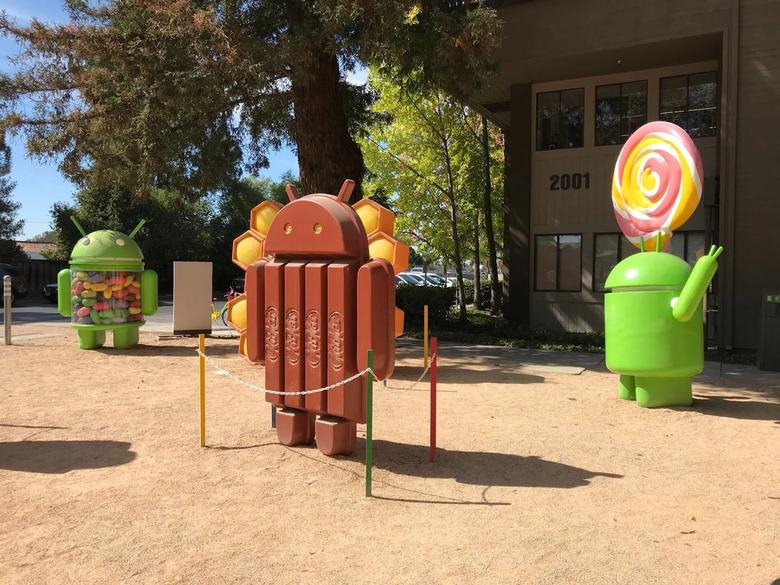
Photo By: Guido Coppa
After making the journey to Googleplex, employees and visitors are greeted with all types of food and alluring art pieces. If you’re looking for an eye appealing and interactive day, check out the Google Android Statues Square. This sculpture garden creates a new and colorful candy-themed Bugdroid sculpture every time the newest operating system (O.S.) is developed. Close to this garden rests the company store, where you can find wearables and all other types of accessories.
If exploring the heart of Googleplex is the goal, building 43 is full of note-worthy spectacles, from nap pods to a replica of Richard Branson’s Spaceship One (which hangs from the ceiling). An iron replica of Stan the T-Rex guards the front entrance. Back in the early 2000s, Google got press from the Stan vs flamingos scandal. This incident occurred as mysterious lawn-flamingos covered Stan’s skeleton from head to tail. The founders used this event as inspiration for their employees: do not become irrelevant like a dinosaur. To this day, anonymous employees will sneak a flamingo onto Stan if they get the chance.
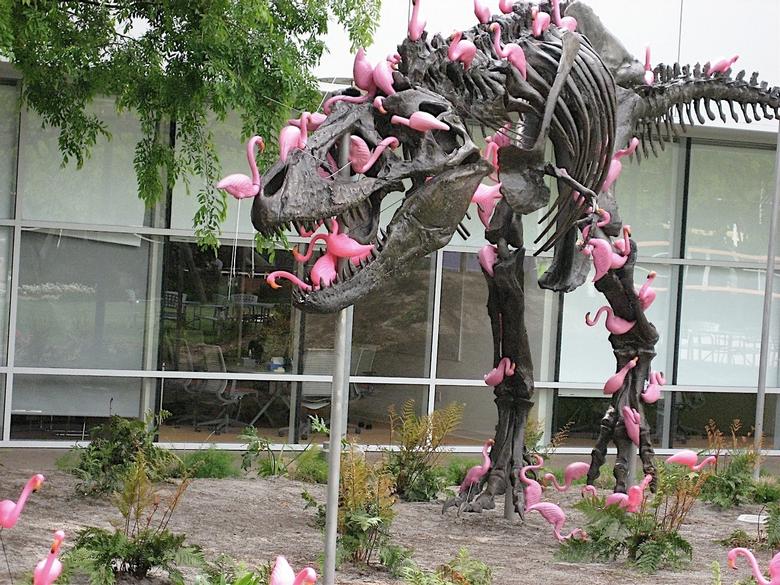
Photo Credit: boingboing.net
All in all, these features make for a unique workplace experience. Mayra Felix, E-commerce & DTC at Google, sums up her experience at Googleplex by “[getting] lunch at one of the three cafés on my side of the campus and will venture to new ones across campus if I have time. I try to take breaks by walking my coworker's dog, getting a snack in the micro kitchen, or working out at the gym if I'm feeling energetic”. Evidently, Googleplex is a campus both favorable to look at and work at!
Workplace Culture
Although its environment may sound unbeatable, the company culture may be an even greater perk. Google was ranked as one of the best companies to work for in the annual Top 100 of Fortunes’ magazine. Google constantly pushes themselves to promote creativity and nurture their employees, from the innovative workspace to their people-first mindset. And, as prominent Googlers note, these two things might not be as separate as you'd think.
The former executive chairman, Eric Schmidt, notes the importance of culture to aid in innovation. He understood that to stay competitive, Google must evolve, and to do that, the company must have an open-minded culture. As Schmidt notes, “Ultimately, company culture and innovation can’t be separated. You have to have the culture...and you need to get it right”.
For Googleplex, the main goal is not to be “by the book”, but to nurture a culture that overall brings forth productivity and creativity. Employees are free to work in many different spaces and given the tools, and food, to get the job done.
The operations conducted in Googleplex specialize in internet-related services and products. Some of this include cloud computing, online advertising technologies, search engine development, software, and hardware. A cutting edge product based on campus is Google Glass. This eyewear is an optical head mounted display which allows the user to broadcast what they are seeing through their glasses with voice command functions.
Perks of Google Headquarters
While an obvious perk is the prestige that comes from working at Google, there are many other upsides to this company. The location itself, centered in Silicon Valley, makes it a hub for Google employees to network and draw in potential recruits. Facebook, based in Menlo Park, is another famously large company based in the bay area.
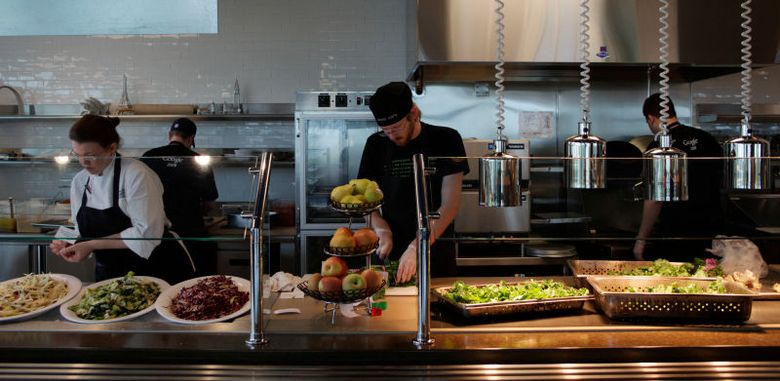
Photo Credit: Gawker
As a Googler, you will never go hungry, as the campus provides free breakfast, lunch, and dinner at various locations. One of the largest cafeterias in Googleplex, called “Big Table”, serves a large variety of options. Between a pizza bar, noodle bar, salad bar, and many ethnic food options, there is always something delicious waiting for you. Even if you don't like the on-campus option, you have over 30 off-campus cafes to choose from.
On your walks around campus, you're bound to see Google's "organic lawn mowers". Herds of goats (yes, goats) roam around to mow the lawn for Google. While you may think getting goats is more cost-effective than real lawn mowers, surprisingly, the cost of getting and maintaining these goats is similar. Thankfully, Google seems to keep them around for the enjoyment of their employees rather than from the high-quality service they get out of these herbivores.
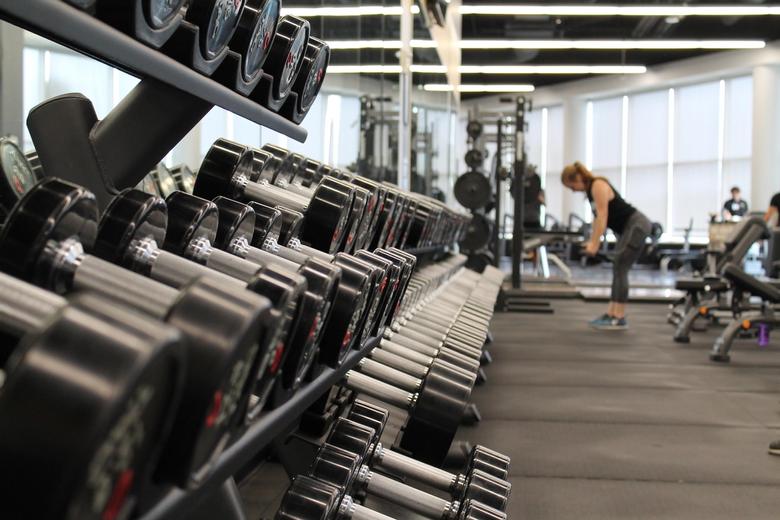
While working on campus, there are countless amenities available that enhance "work-life blend." As mentioned before, nap pods are available for both work and sleep. If you’re feeling energetic rather than tired, you can work-out at one of the on-campus gyms. There are also interactive activities, such as volleyball or ping-pong, to stretch your body after working for so long. If outdoor sports aren't your speed, you can take your dog for a walk during the workday. This campus is a dog-friendly place, so you can bring your best self to work with your best friend. Say your clothing gets dirty after a volleyball game or a dog-walking mishap. Not an issue, as Googleplex provides several laundry facilities (and even has dry cleaning services!).
The final, yet taken-for-granted perk of working at Googleplex is the 80/20 rule. This rule allows employees to dedicate 80% of their time to their primary job, and 20% toward personally-driven projects that would help the company. And after completion of a project well done, coworkers can give each other “massage credits” which can be redeemed for a free hour long massage on campus. The only downside is your puppy may have to wait outside.
The information provided herein is for general informational purposes only and is not intended to provide tax, legal, or investment advice and should not be construed as an offer to sell, a solicitation of an offer to buy, or a recommendation of any security by Candor, its employees and affiliates, or any third-party. Any expressions of opinion or assumptions are for illustrative purposes only and are subject to change without notice. Past performance is not a guarantee of future results and the opinions presented herein should not be viewed as an indicator of future performance. Investing in securities involves risk. Loss of principal is possible.
Third-party data has been obtained from sources we believe to be reliable; however, its accuracy, completeness, or reliability cannot be guaranteed. Candor does not receive compensation to promote or discuss any particular Company; however, Candor, its employees and affiliates, and/or its clients may hold positions in securities of the Companies discussed.
